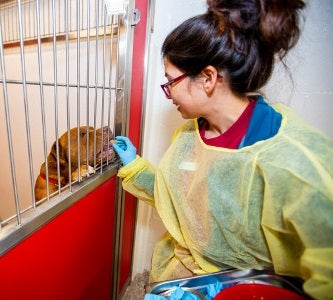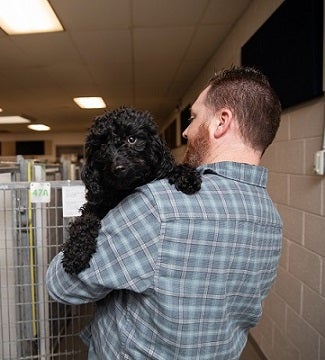
Media strategy a critical part of response to disease outbreaks
5/9/2023
A few weeks ago, spurred by the sheer volume of reports about canine disease outbreaks in shelters and rescue facilities lately, we spoke with Best Friends medical director Erin Katribe, DVM, to get her insights on preventing and managing distemper, parvo and canine influenza. She outlined key steps for shelters, including putting preventative measures in place, implementing aggressive treatment protocols, utilizing fosters to reduce risk, and limiting intake to emergencies only.
Another challenge inherent in dealing with disease outbreaks we didn’t touch on, however, is the part where organizations must communicate what’s happening with the public. And make no mistake, shelters and rescues must be transparent with the community about what they’re facing behind closed doors.
“It is incredibly important to let the community know what is happening in the shelter and how they can help,” says Monica Dangler, director of Pima Animal Care Center (PACC) in Tucson, Arizona. “Our communities want to help us, but they can’t if they don’t know we need it.”
While the logic of doing so is certainly sound, the reality is that animal welfare organizations are often afraid to let the public know the truth.
“In my experience, organizations are concerned about adding to the public perception that shelters are full of sick pets,” says Whitney Bollinger, director of strategy and network operations at Best Friends. Whitney has overseen veterinary communication efforts at several shelters throughout her many years in the industry, including Dallas Animal Services and Austin Humane Society. “The fear is, that stigma will lead to fewer positive outcomes and exacerbate the problem by increasing length of stay. However, proactive communication often has the opposite impact because the community respects the organization’s transparency and detailed planning.”
Paula Powell, manager of the south central region at Best Friends and former director of El Paso Animal Services (EPAS), likewise has seen directors avoid being transparent out of fears of losing their jobs in addition to the above issues.
“The biggest concern is that the public will think they are not doing their job,” says Paula, who worked at EPAS for 26 years. “The public perception is that they just want to close down because they are lazy and there is no real disease, or because there is always disease, and the shelter is just letting strays run wild. You need to explain the true rationale.”
There are ways of managing the message to not only reduce or eliminate public backlash, but also to enlist the community in protecting animals and bolstering efforts within the shelter. The result? More lives are saved, and the shelter and the public take critical steps towards a future where community-supported animal sheltering is a reality.
Diagnosing the disease(s)
 Every shelter has the potential to experience a disease outbreak, but since December, PACC has been coping with three outbreaks of a particularly nasty canine disease: streptococcus zooepidemicus (strep zoo). Strep zoo is common in horses but can spread to other species. Initial signs may be mistaken for kennel cough, but affected dogs often showed severe respiratory distress and a rapidly deteriorating clinical condition. Symptoms may progress to the point of a fever ranging from 102.5 to 107 degrees and vomiting blood, and strep zoo can move so rapidly that some dogs are even found deceased in their kennels without having shown any clinical signs. Knowing how aggressive strep zoo can be and having dealt with it several times in the past, PACC already had communications protocols ready to go.
Every shelter has the potential to experience a disease outbreak, but since December, PACC has been coping with three outbreaks of a particularly nasty canine disease: streptococcus zooepidemicus (strep zoo). Strep zoo is common in horses but can spread to other species. Initial signs may be mistaken for kennel cough, but affected dogs often showed severe respiratory distress and a rapidly deteriorating clinical condition. Symptoms may progress to the point of a fever ranging from 102.5 to 107 degrees and vomiting blood, and strep zoo can move so rapidly that some dogs are even found deceased in their kennels without having shown any clinical signs. Knowing how aggressive strep zoo can be and having dealt with it several times in the past, PACC already had communications protocols ready to go.
“Since January, our staff has been split into several teams to prevent exposure between various populations of dogs,” says PACC director Monica Dangler. “This makes it extremely challenging to evaluate, sterilize, and provide enrichment for our dogs, not to mention getting them adopted. Typically, when an outbreak is suspected, even before it is confirmed with testing, we begin communicating with the public and asking for adopters and fosters to reduce the shelter population.”
Oklahoma City Animal Welfare (OKC Animal Welfare) is another organization that faced a recent challenge with strep zoo and implemented a media strategy to help overcome it.
“In late March, the staff veterinarian came to me after her morning walk through to say 50 dogs were showing signs of upper respiratory infections (URIs),” says OKC Animal Welfare superintendent Jonathan Gary. “URIs are not unusual at our high-intake shelter, so the assumption was that this was a typical outbreak. But the following day, another 30 dogs showed signs. The next day, another 40 fell ill. In 24 years here, I’d never seen something travel through the kennels so rapidly. We knew we were facing something very atypical.”
OKC Animal Welfare made the difficult decision to close on March 30 and began testing the dogs to determine what they were dealing with. They also began treatment, whether or not the dog was showing symptoms. On April 2, test results confirmed the vet’s suspicion: the shelter was dealing with an outbreak of both canine influenza and strep zoo.
“So far, we’ve had 298 dogs show symptoms,” Jonathan says. “Five died on their own, three were euthanized because they declined rapidly and several others were euthanized because we knew that, even if we could get them well, we wouldn’t be able to adopt them out due to their behavior issues.”
Although the shelter had never dealt with such an issue before and so did not have a plan at the ready, they nonetheless reached out to the public within a day of determining they were dealing with something more than a URI outbreak.
“We had residents who recently reclaimed or adopted dogs from us, as well as several partners who had transferred our dogs into their programs,” says Jonathan. “We notified staff first, volunteers and partners second, and then our community through a press release.
“Transparency is important to us, and this situation wasn’t treated any differently in terms of letting the public know what was happening at the shelter,” he adds. “We crafted our message around honesty and being clear on what we needed the community to do to help us. That part was very important because we knew we were going to need their help to get through this.”
Crafting your message
As far as what should go into the message, there’s no reason organizations need to start from scratch. In fact, EPAS (example #1, example #2) and PACC (example #1, example #2) each shared press releases for shelters and rescues to use. Primarily, though, the message needs to be candid.
“First, if we aren't honest and transparent, then we can't engage the public to help and we need them more than ever in crisis situations,” says Best Friends medical director Dr. Erin Katribe. “While we must be a little more selective in what we're asking of them so that we don't spread disease into the community, we will absolutely need their help to save as many lives as possible.
“Second, transparent communication is essential to building trust, which is crucial to long-term lifesaving,” Erin continues. “If shelters try to hide the crisis or don't talk openly about the problem and what they're doing to address it, the public or transfer partners can feel deceived and may be reluctant to adopt or receive animals in the future.”
 Decide whether you want to ask people to foster for the shelter, and/or request that people who find healthy stray animals hang onto them temporarily rather than bringing them to the shelter. That will keep those pets from being exposed to disease and avoid overwhelming an already-taxed staff.
Decide whether you want to ask people to foster for the shelter, and/or request that people who find healthy stray animals hang onto them temporarily rather than bringing them to the shelter. That will keep those pets from being exposed to disease and avoid overwhelming an already-taxed staff.
“We educate citizens of Pima County about the potential disease and how it can potentially impact them, and we are always mindful that our communications need matches the threat level,” Monica says. “If it’s just one dog severely impacted and the rest of the population seems stable, that will have different communication around it than when multiple dogs are being impacted.”
When EPAS had an outbreak of canine distemper, they put a proactive communication plan into effective immediately that covered risk factors and circumstances that contributed to the outbreak. By sharing such information, the shelter laid the groundwork for a comprehensive managed admissions program, which will help the shelter avoid disease outbreaks in the future and better serve community pets and people.
Don’t be afraid to release new messaging as the shelter situation evolves, either. Conditions can change rapidly with something like strep zoo, meaning that protocols around who can interact with a dog or take one home are in flux. Each time protocols change, PACC communicates about it.
“Our messages are always carefully crafted around the facts about what is happening, though we present information in a way so as to not alarm the community,” Monica says. “We always have our veterinary director in place to approve press releases about disease outbreaks. In some cases, our local health department has also been of assistance, depending on the disease.”
Finally, remember to be crystal clear about your needs.
“Tell people what you need, why you need it, and how to help,” Monica says. “Above all, always be ready. These situations always seem to happen on Friday at 1 p.m. and you need to begin communicating immediately to make the news cycle.”
Preparing for the public response
While not everyone will respond to shelter messaging in a positive way (let’s face it, there are always going to be naysayers no matter what a shelter does), the majority seem to appreciate it. In Oklahoma City, Jonathan reports that both the community and city leadership have been extremely supportive through the recent challenges and Monica says PACC consistently receives a supportive public response.
“Many of them even thanked us for closing and doing what we could do to prevent the spread in the community,” Jonathan says. “You always have a few that are negative, but the understanding and support far outweighed that. We handled negativity with education and the understanding that some people just weren’t going to be happy about our decision.”
“Regardless of how careful we are with our messaging, it’s likely that we'll experience some degree of criticism,” Erin adds. “During outbreaks, this often takes the form of criticism for euthanasia decisions made to protect the rest of the population in shelters without the resources to hang onto pets safely. It can also cause people to criticize shelters that limit intake. Such criticism is related to lack of a thorough understanding of the issue, but messaging can combat this lack of understanding, and engaging with experts in the field of shelter medicine and outbreak response can help add credibility to the shelter's approach.”
Knowing how much your organization can gain from communicating the reality of life in the shelter should help shelters and rescues overcome their fears of the “worst case scenario.”
“I had a recent shelter that determined a lot of their animals were at a low risk for infection with a particular disease,” Erin says. “Rather than communicating about the situation to the public and inviting them in to help, the shelter opted to just hang onto those pets at the shelter. As a result, their puppies—the most vulnerable population—were exposed to a different infectious disease (parvo).
“Had they allowed the public in to help, with transparent and honest education about the risk, those puppies would have been in foster care and avoided a second disease exposure,” she continues. “We must be honest and transparent, but we also must let the public in to help us. While such communication may be tricky, it's possible to message that effectively, and it can mean more lives will be saved.”
For more information about this topic, take a look at our Infectious Disease Outbreak Response playbook.

Liz Finch
Senior Writer
Best Friends Network
If you enjoyed this program spotlight, you can find our complete catalog of spotlights here.